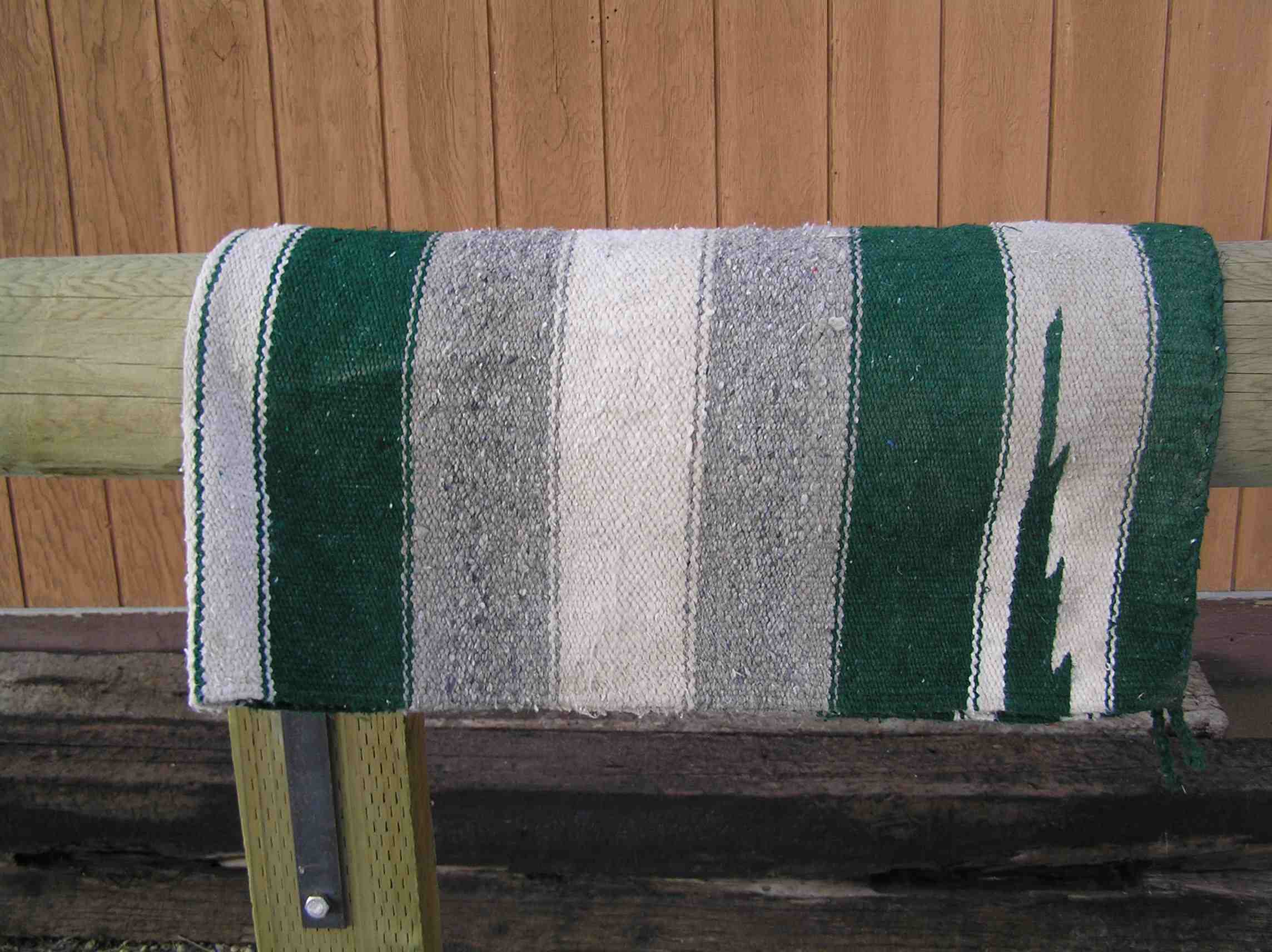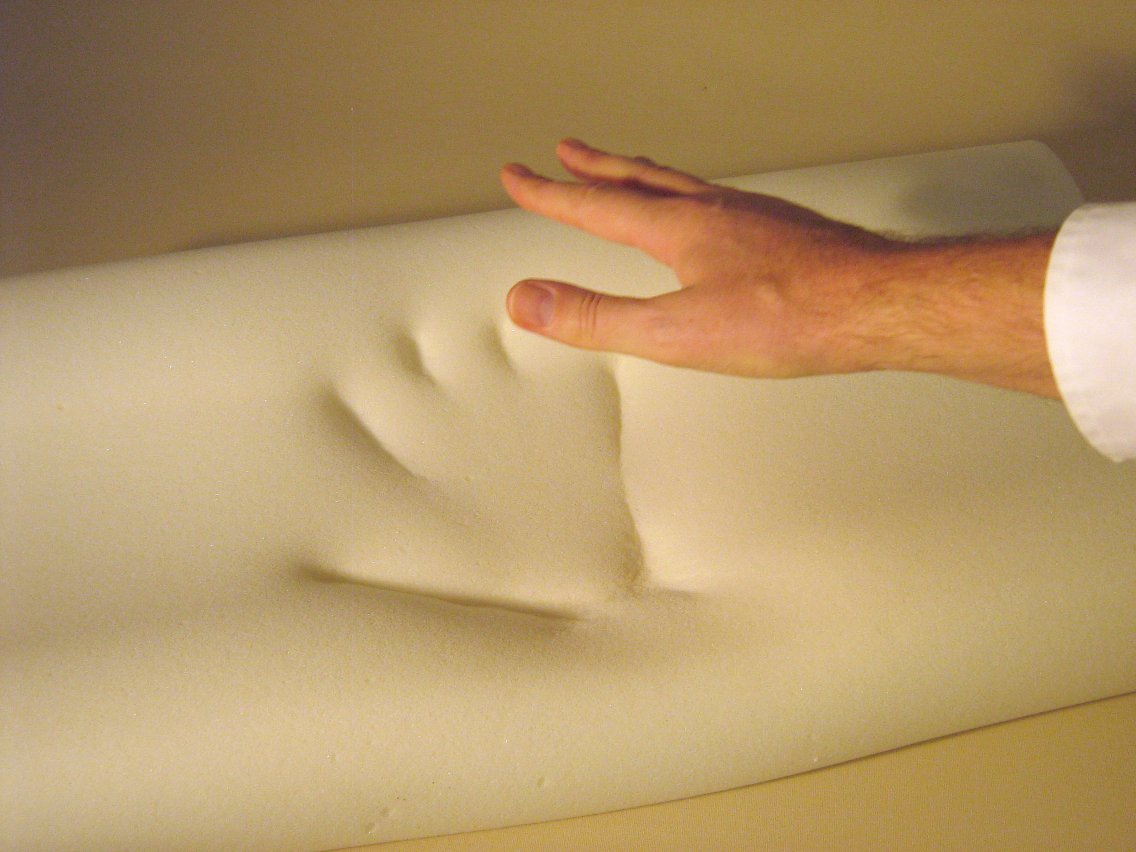|
Saddle Blanket
The terms saddle blanket, saddle pad (or numnah), and saddle cloth refer to blankets, pads or fabrics inserted under a saddle. These are usually used to absorb sweat, cushion the saddle, and protect the horse's back. There are lighter types of saddle cloth, such as the shabrack, used primarily for decorative purposes, often placed over the top of a more utilitarian pad. Saddle blankets have been used for many centuries with all types of saddles. Some are a single thickness, others are made to be folded and used with a double thickness. Although a pad or blanket cannot take the place of a properly fitted saddle, pads with shims or blankets with a special design can partially compensate for minor fitting problems. The most blanket-like style is associated with the American-style western saddle. It is usually made of wool, cotton, or synthetic fabrics with similar characteristics. When fitted under the saddle, they are approximately square, although designs vary to fit ho ... [...More Info...] [...Related Items...] OR: [Wikipedia] [Google] [Baidu] |
Domestication Of The Horse
A number of hypotheses exist on many of the key issues regarding the domestication of the horse. Although horses appeared in Paleolithic cave art as early as 30,000 BCE, these were wild horses and were probably hunted for meat. How and when horses became domesticated has been disputed. The clearest evidence of early use of the horse as a means of transport is from chariot burials dated c. 2000 BCE. However, an increasing amount of evidence began to support the hypothesis that horses were domesticated in the Eurasian Steppes in approximately 3500 BCE. Discoveries in the context of the Botai culture had suggested that Botai settlements in the Akmola Province of Kazakhstan are the location of the earliest domestication of the horse. Warmouth et al. (2012) pointed to horses having been domesticated around 3,000 BC in what is now Ukraine and Western Kazakhstan. Genetic evidence indicates that domestication of the modern horse's ancestors likely occurred in an area known as the ... [...More Info...] [...Related Items...] OR: [Wikipedia] [Google] [Baidu] |
Saddle Bl
The saddle is a supportive structure for a rider of an animal, fastened to an animal's back by a girth. The most common type is equestrian. However, specialized saddles have been created for oxen, camels and other animals. It is not known precisely when riders first began to use some sort of padding or protection, but a blanket attached by some form of surcingle or girth was probably the first "saddle", followed later by more elaborate padded designs. The solid saddle tree was a later invention, and though early stirrup designs predated the invention of the solid tree, the paired stirrup, which attached to the tree, was the last element of the saddle to reach the basic form that is still used today. Today, modern saddles come in a wide variety of styles, each designed for a specific equestrianism discipline, and require careful fit to both the rider and the horse. Proper saddle care can extend the useful life of a saddle, often for decades. The saddle was a crucial step in ... [...More Info...] [...Related Items...] OR: [Wikipedia] [Google] [Baidu] |
Horse Blanket
A horse blanket or rug is a blanket or animal ''coat'' intended for keeping a horse or other equine warm or otherwise protected from wind or other elements. They are tailored to fit around a horse's body from chest to rump, with straps crossing underneath the belly to secure the blanket yet allowing the horse to move about freely. Most have one or two straps that buckle in front, but a few designs have a closed front and must be slipped over a horse's head. Some designs also have small straps that loop lightly around the horse's hind legs to prevent the blanket from slipping sideways.Price ''The Whole Horse Catalog'' rev. ed. p. 192-194 Protection from the elements Standard horse blankets are commonly kept on a horse when it is loose in a stall or pasture as well as when traveling. Different weights are made for different weather conditions, and some are water-resistant or waterproof. Modern materials similar to those used in human outdoor wear are commonly used in blanket ma ... [...More Info...] [...Related Items...] OR: [Wikipedia] [Google] [Baidu] |
Memory Foam
Memory foam consists mainly of polyurethane with additional chemicals that increase its viscosity and density. It is often referred to as "viscoelastic" polyurethane foam, or low-resilience polyurethane foam ( LRPu). The foam bubbles or ‘cells’ are open, effectively creating a matrix through which air can move. Higher-density memory foam softens in reaction to body heat, allowing it to mold to a warm body in a few minutes. Newer foams may recover their original shape more quickly. Mechanics Memory foam derives its viscoelastic properties from several effects, due to the material's internal structure. The network effect is the force working to restore the foam's structure when it is deformed. This effect is generated by the deformed porous material pushing outwards to restore its structure against an applied pressure. Three effects work against the network effect, slowing the regeneration of the foam's original structure: * The pneumatic effect, caused by the time it takes air ... [...More Info...] [...Related Items...] OR: [Wikipedia] [Google] [Baidu] |
Lordosis
Lordosis is historically defined as an ''abnormal'' inward curvature of the lumbar spine. However, the terms ''lordosis'' and ''lordotic'' are also used to refer to the normal inward curvature of the lumbar and cervical regions of the human spine. Similarly, kyphosis historically refers to ''abnormal'' convex curvature of the spine. The normal outward (convex) curvature in the thoracic and sacral regions is also termed ''kyphosis'' or ''kyphotic''. The term comes from the Greek lordōsis, from ''lordos'' ("bent backward"). Lordosis in the human spine makes it easier for humans to bring the bulk of their mass over the pelvis. This allows for a much more efficient walking gait than that of other primates, whose inflexible spines cause them to resort to an inefficient forward leaning "bent-knee, bent-waist" gait. As such, lordosis in the human spine is considered one of the primary physiological adaptations of the human skeleton that allows for human gait to be as energeti ... [...More Info...] [...Related Items...] OR: [Wikipedia] [Google] [Baidu] |
Withers
The withers is the ridge between the shoulder blades of an animal, typically a quadruped. In many species, it is the tallest point of the body. In horses and dogs, it is the standard place to measure the animal's height. In contrast, cattle are often measured to the top of the hips. The term (pronounced ) derives from Old English ''wither'' (“against”), because it is the part of a draft animal that pushes against a load. Horses The withers in horse The horse (''Equus ferus caballus'') is a domesticated, one-toed, hoofed mammal. It belongs to the taxonomic family Equidae and is one of two extant subspecies of ''Equus ferus''. The horse has evolved over the past 45 to 55 million ...s are formed by the dorsal spinal processes of roughly the 3rd through 11th thoracic vertebrae, which are unusually long in this area. Most horses have 18 thoracic vertebrae. The processes at the withers can be more than long. Since they do not move relative to the ground a ... [...More Info...] [...Related Items...] OR: [Wikipedia] [Google] [Baidu] |
Dressage
Dressage ( or ; a French term, most commonly translated to mean "training") is a form of horse riding performed in exhibition and competition, as well as an art sometimes pursued solely for the sake of mastery. As an equestrian sport defined by the International Equestrian Federation, dressage is described as "the highest expression of horse training" where "horse and rider are expected to perform from memory a series of predetermined movements." Competitions are held at all levels from amateur to the Olympic Games and World Equestrian Games. Its fundamental purpose is to develop, through standardized progressive training methods, a horse's natural athletic ability and willingness to perform, thereby maximizing its potential as a riding horse. At the peak of a dressage horse's gymnastic development, the horse responds smoothly to a skilled rider's minimal aids. The rider is relaxed and appears effort-free while the horse willingly performs the requested movement. The disc ... [...More Info...] [...Related Items...] OR: [Wikipedia] [Google] [Baidu] |
Show Jumping
Show jumping is a part of a group of English riding equestrian events that also includes dressage, eventing, hunters, and equitation. Jumping classes are commonly seen at horse shows throughout the world, including the Olympics. Sometimes shows are limited exclusively to jumpers. Sometimes jumper classes are offered in conjunction with other English-style events. Sometimes, show jumping is but one division of a very large, all-breed competition that includes a very wide variety of disciplines. Jumping classes may be governed by various national horse show sanctioning organizations, such as the United States Equestrian Federation or the British Showjumping Association. International competitions are governed by the rules of the International Federation for Equestrian Sports. Hunters or jumpers Show jumping events have hunter classes, jumper classes and hunt seat equitation classes. Hunters are judged subjectively on the degree to which they meet an ideal standard of man ... [...More Info...] [...Related Items...] OR: [Wikipedia] [Google] [Baidu] |
Eventing
Eventing (also known as three day eventing or horse trials) is an equestrian event where a single horse and rider combine and compete against other competitors across the three disciplines of dressage, cross-country, and show jumping. This event has its roots in a comprehensive cavalry test that required mastery of several types of riding. The competition may be run as a one-day event (ODE), where all three events are completed in one day (dressage, followed by show jumping and then the cross-country phase) or a three-day event (3DE), which is more commonly now run over four days, with dressage on the first two days, followed by cross-country the next day and then show jumping in reverse order on the final day. Eventing was previously known as Combined Training, and the name persists in many smaller organizations. The term "Combined Training" is sometimes confused with the term "Combined Test", which refers to a combination of just two of the phases, most commonly dressage an ... [...More Info...] [...Related Items...] OR: [Wikipedia] [Google] [Baidu] |
British English
British English (BrE, en-GB, or BE) is, according to Lexico, Oxford Dictionaries, "English language, English as used in Great Britain, as distinct from that used elsewhere". More narrowly, it can refer specifically to the English language in England, or, more broadly, to the collective dialects of English throughout the British Isles taken as a single umbrella variety, for instance additionally incorporating Scottish English, Welsh English, and Ulster English, Northern Irish English. Tom McArthur (linguist), Tom McArthur in the ''Oxford Guide to World English'' acknowledges that British English shares "all the ambiguities and tensions [with] the word 'British people, British' and as a result can be used and interpreted in two ways, more broadly or more narrowly, within a range of blurring and ambiguity". Variations exist in formal (both written and spoken) English in the United Kingdom. For example, the adjective ''wee'' is almost exclusively used in parts of Scotland, North E ... [...More Info...] [...Related Items...] OR: [Wikipedia] [Google] [Baidu] |






